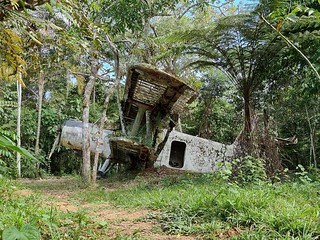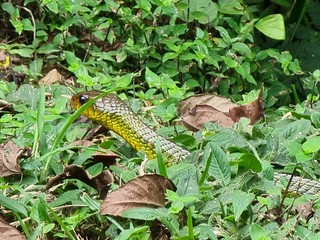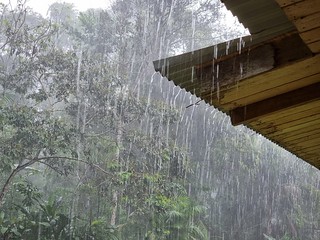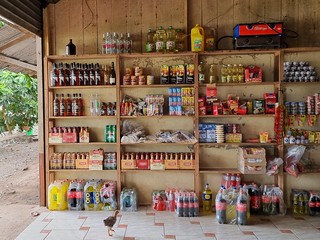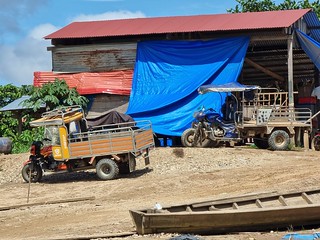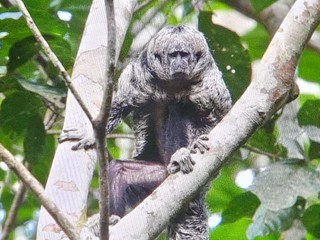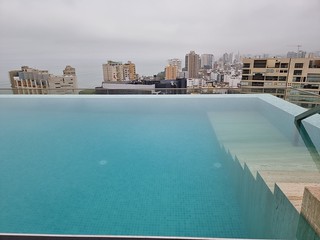Julkaistu alun perin Instagramissa.
8.7
Carretera a Manu, the Manu Road, is sometimes so hairy that the same dust that your vehicle generates is sucked in when you drive around the bend. The dry season is still young but the amount of fine-grained, yellowish dust is already epic.
The road begins after Paucartambo, a three hour ride from Cusco. Today, this first leg, Carretera a Cusco, is paved, which means potentially (and also actually) faster driving. Your stomach switches to alert mode if you are me and sit on the back.
The Manu Road ends in Atalaya, by the shore of the river Alto Madre de Dios. In 2007 the only option from Atalaya onwards, from the department of Cusco to the department of Madre de Dios, was by boat. Now there is also a road. It follows Alto Madre de Dios on its Southern side until Boca Manu, the local traffic hub with an airstrip. Google maps don’t show the last leg from Shintuya to Boca Manu but it’s there. We will not use the road though but will embark on a boat. First to Boca Manu. Then, sharp right, and we sail on Madre de Dios the rest of this journey.
In September 2007 all roads were still gravel. Many a thing has changed in 15 years but one remains. David Fuerte was our guide then, and he is our guide now. It must be Cusco’s altitude of 3000 meters where David lives or his frequent guiding trips through the humid montane forests of the Andes down to the lowland Peruvian Amazon or maybe both, but he doesn’t look a day older.
Estación Biológica Wayqecha sits right next to the Manu Road, on a scenic, steep slope of the Kosñipata River valley. That said, slopes here belong to only two categories: A. steep or B. really steep. Both are scenic.
Here, bordering Manu National Park, just below 3000 m, you are saved of the inescapable headache of Cusco, but any physical activity like sliding into bed after 9 pm when the 6-to-9 generator is turned off and blackness is turned on, results in serious panting.
Stars! As if someone had wiped clean the big celestial window from all accumulated dirt. Venus shines boldly in low East until a quarter to 6 am when the last Broad-eared bats return from their nocturnal shift and fly underneath the cabin roof as effortlessly as only bats can do.
[Identification of the bat species thanks to the Echo Meter Touch 2 Pro ultrasonic module by Wildlife Acoustics Inc.]
Wayqecha is one of three lodges operated by ACCA (La Asociatión para la Conservatión de la Cuenca Amazónica). The main object of research at the moment is the Spectacled bear, a small photogenic bear with distinctive white face markings. “So far we have identified nine different individuals from camera trap photos”, tells Ruthmery Pillco Huarcaya, the science coordinator at Wayqecha.
Camera traps are in heavy use. 60+ are in operation in any given time. One can only imagine what it takes to install and maintain the lot. In normal conditions, the battery lasts roughly one year. Wayqecha is not normal in that sense. For one thing, it’s cold and humid. Secondly, bears. Curious and strong, they are famous of bringing havoc to the camera world. One of the items on the donation wish list of ACCA is a camera trap, 250 US dollars. “My team checks all cameras every other month.” The cost of one of these field research trips is 1000 USD.
Radio collars are another state-of-the-art technology in the field of biological sciences. Here, the team is moving at that direction too.
The mascot of Wayqecha is Ukuku, a rescue dog trained to find bear excrement.
10.7
After a rainy day, colors are left hanging in the sky to dry.
Andean Guan #penelopemontagnii climbs on the top branch of a lichen-and-moss-laden tree to catch the most of the early morning sun. Other common birds are Hooded Mountain Tanager #buthraupismontana, Masked Flowerpiercer #diglossopiscyanea, Great Trush #turdusfuscater, Rufous-collared Sparrow #zonotrichiacapensis, Grass-green Tanager #Chlorornisriefferii and of course numerous hummingbird species. Follow tags for photos.
One must appreciate the way the small kitchen was able to deliver three meals a day in six days without repeating the dishes once.
Potato is a core ingredient, followed closely by rice, and chicken. Tofu is a newcomer. Every dinner starts with a hot soup, often accompanied by a lingering scent of coriander. Desserts are light and delicious.
11.7
To descend from the mountains to the level of 700 m of Pillcopata and the next research station-cum-lodge of ACCA, Villa Carmen, is like moving fast forward to another season. Everything changes in one way or other: temperature, humidity, vegetation, animals – you included. The more tropical it gets, the more you, a traveller, begin to be aware of your inevitable place in the big picture. No longer are you just a cool observer, capable of making your own decisions as you please. From now on you have to admit that there is fairly little you can do just by reasoning; you must adapt.
At daytime, Wayqecha was almost empty of insects give or take few smallish butterflies at high noon, sand flies, bees, some small spiders, and one stubborn shield bug that kept crawling back into the cabin underneath the door. Zero ants, for instance. No mosquitos whining into your ear.
After 6 pm though, moths in various sizes began to bounce against the glass windows, distracted by the temptingly bright artificial light inside. Beyond 1000 m, beetles and allies. 700 m, ants, and bigger butterflies. Moths increase in size and color palette. Mosquitos.
12.7
Villa Carmen used to be a hacienda, a farm. Now it is returning to its more natural state. A slow process.
The former owner, Abel Muñiz, was a man of visions and passionate about improvements in agriculture, sharing his knowledge with locals, we are told. Then, during the first decade of the 21st century, he decided to move on.
In the forest trails, you are surrounded by bamboos. They are a dominant “evergreen perennial flowering plant” (Wikipedia). You need to mentally pinch yourself that hello! this is South America, not Asia. Zigzagging the canopy with their long, green stem that, when bent enough by the wind, age or whatever, bamboos start to produce vertical shoots from its nodes.
Unburnable, bamboo has unique uses. David tells that Peruvians cook fish in bamboo stalks. Google with ‘Pacamoto’.
Bamboo forest floor is covered with pale bamboo leaves. Suddenly, you encounter a rolling swarm of black caterpillars.
Abel Muñiz didn’t operate on land only. In 1990 he started the region’s first cargo airline, Aero Manu. The fleet of 7 biplane Antonov An-2 Russian airplanes traded forest goods across the Peruvian Amazon and into Brazil.
Aero Manu was short-lived. Three non-fatal aircraft accidents resulted in law suits which put an end to the business in 1991.
When you come out of the bamboo forest into a big open field with waist-high grass and a few scattered trees, it’s like walking straight into a Werner Herzog movie. The field is a former airstrip. In the far corner, barely noticable due to all vegetation and debris, is one An-2.
It is a philosophical sight.
An-2 was – and is – sort of a dream machine. “Its remarkable durability, high lifting power, and ability to take off and land from poor runways have given it a long service life.” (Wikipedia).
I know nothing about airplanes but this is crazy:”The slow stall speed [the minimum speed needed for an airplane to produce lift, 48 km/h for
An-2} makes it possible for the aircraft to fly backwards relative to the ground: if the aircraft is pointed into a headwind of roughly 56 km/h, it will travel backwards at 8 km/h whilst under full control.”
The cave-like fuselage is now home to Seba’s short-tailed bats #carolliaperscipillata, and Pallas’s Long-tongued bats #glossophagasoricina
Reptiles are masters of surprise.
There you walk in your rubber boots, heading for the cabin to catch some Zs after lunch. The gravel path runs first along the restaurant building, and then takes a sharp dip down the hill. The hillside is supported by a stone wall, so tall that your eyes are on the level of the lawn that spreads from the top of the wall until the back side of the restaurant where the kitchen is.
You glance up, and look into a black eye that sits in a yellow-green, raised head.
The Yellow-bellied puffing snake #Pseustessulphureus is venomous, and can grow up to 3 meters. This individual looked full grown. The snake eats small mammals, and birds. The theory is that this one was after rats.
13.7
It’s been raining now for almost two days in a row. While rain reduces activity, extra water is welcomed. The local Piñi-Piñi River feeds Alto Madre de Dios, our waterway tomorrow. Two weeks ago, David told, the water level was so low that they had to push the boat every now and then.
The plan is to land before dark to the next stay, Manu Wildlife Center on the bank of Madre de Dios. David’s educated guess is that the boat ride will take 8 hours.
Measuring the distance with Google Maps by dropping several pins along the meandering rivers, I came up to the rough figure of 91 miles (145 km) between Atalaya and MWC. That’d mean a whopping speed of 18 km/h. Probably an underestimation. Still, we are not talking about speed boats here, and then there is the unknown pushing factor.
Our car driver, Bruno Lora Moreno, will drop us to Atalaya and return to Cusco where he lives. Incidentally, tomorrow is also the day when thousands of Peruvians start to flock in and around Paucartambo, a city you cannot avoid. Fiesta de la Virgen del Carmen de Paucartambo #paucartambofiestavirgendelcarmen is a yearly Catholic festival but with strong party vibes. Traffic will be catastrophic.
The little I’ve come to know Bruno during these last 10 days, he seems to be an easy-going person. He’ll survive the fiesta chaos. When not driving tourist vans, Bruno plays trombone in a popular music band. A nice combination I think.
18.7
Halfway from Atalaya to Manu Wildlife Center, overlooking Madre De Dios River, is Boca Manu.
We hoped that we’d meet again the pet Mealy Parrot in the village shop just next to the river bank. In 2007, the parrot gave the best laughs of the whole trip, also literally. The parrot giggled just like ladies are supposed to. And we giggled back. Etc. I cannot fathom why some parrot species are able to imitate the human voice so well. Is there a Turing test for parrots?
The parrot was gone. Much of what used to be the village of Boca Manu in the past was gone too.
Every year, particularly in this area, Madre de Dios flushes its banks with 5 meters a pop. Since 2007, land of the size of a football field has disappeared. The village is constantly backing up away from the river.
On the Southern side of Madre de Dios is a parking area of several trucks, cars, and other vehicles. Scattered around the sandy beach, they are waiting for stuff from the village to be delivered to Cusco.
The new road is changing life here. David predicts that the number of families in Boca Manu will increase. In 2007, it was around 60.
Around 6,5 hours from Atalaya to MWC. No difficulties on the way except the last mile. In the small tributary to Madre de Dios, just before the lodge, the water level was so low that the captain’s helper Rafael had to stand in front, and push the boat forward with a five meter long pole. Samuel, the captain, and Rafael are members of the Diamante community that lives by the river. They know their Madre de Dios. And to know you must; the river is filled with logs from upstreams.
18.7
To return to some place years after is risky. Changes happen, and not always for the better. Fifteen years ago, Manu Wildlife Center was a bustling lodge. Elegant wooden cabins surrounded by a garden of fruit trees and flowers. Saddleback Tamarins were having siesta near the restaurant, and Vanessa the Tapir who was a wild animal but oddly enough appeared regularly to get some care. It must be one of the strangest things I’ve ever done when I pulled huge ticks from her skin.
Three years ago, because of COVID-19, the lodge was shut down. There were changes in the ownership structure, and part of the property was sold.
In this climate, buildings need constant care. The shutdown was devastating.
Now there is family who lives in the premises, fixes the 20+ cabins as best they can, one by one, and serves the tourists that happen to find themselves here. We came for three nights because we needed to split the long boat trip to our last destination in the Amazonian lowlands, Los Amigos Biological Station. Except for us, there were two photographers who stay in MWC for four weeks.
The restaurant is a big building with separate areas for the restaurant itself, a bar, an annex with hammocks, and quiet corners to discuss day’s adventures in a comfy chair, over a glass of pisco sour. Enough place at least for 50 people.
Eerie. Just emptiness. Also, no light bulbs. All the meager amount of electricity the generator produces in the evening, goes to a tired ceiling fan, and a small battery charging station. Some candles here and there, making the blackness even blacker.
The garden is left unkept, which is understandable. Priorities. The garden floor is littered with rotten oranges, mandarins, and grapes. Wasps build nests in the bigger fruits. At night, your sleep is broken when an orange falls on the roof with a thump.
Despite of the nagging feeling that you are a witness to an apocalypse, Manu Wildlife Centre still has a few things to offer. One of them is two very tall looking towers, the older one owned by the lodge itself.
The basic idea is the same: a wooden platform is built in the canopy of a kapok tree #ceibapentandra. You ascend there via a cable-supported, metallic staircase that stands close to the tree, and looks like a tower.
The one at MWC was built around 1995. Height: 43 m. The staircase is cylindrical in shape, so you just walk round and round the central pole. The newer one is dated 1999. Height: 50 m. Here you walk back and forth inside a rectangular construction.
A 400-500 old kapok tree is a masterpiece of Neotropics. The canopy spreads far in all directions. Branches are thicker than regular tree trunks. Even though you stand so high up with nothing much between you and the ground 50 meters down, the stoic presence of the tree feels very comforting.
The much more famous attraction, a 40 minute boat ride from Manu Wildlife Lodge, is the Macaw clay lick of Blanco Blanquillo Private Reserve.
In September 2007, the number of different parrot species and the total number of birds was staggering. David told that the month of June is totally dead. Zero birds. In July, when the dry season is in its infancy, the activity is slowly increasing, peaking in September.
This time it was clear why smaller parrots like parakeets were not around. Roadside Hawks #buteomagnirostris and Black Caracaras #daptriusater patrolled the area.
Birds come to the lick to eat clay. Clay acts as an antidote to all the toxic stuff they eat. If some species are missing like the iconic Scarlet Macaws #aramacao this time, it can be an indication that birds nearby are eating more non-toxic food. Birds can of course choose among several natural licks. From their point of view, there’s nothing special in this particular one.
Red-and-green Macaws #arachloropterus were present. The only other parrot species during the 6-hour long stay in the hide, 70 meters from the vertical clay lick, was Blue-headed Parrot #pionusmenstruus.
One animal species is thriving around the lick hide, and it’s the honey bee. Every group carries a box breakfast with pancakes, maple syrup and other wonderful, yummy stuff.
19.7
The 6 hour boat drive down Madre de Dios from Manu Wildlife Centre to Los Amigos Biological Station is also a short introduction to the recent history of mankind.
Halfway, at Boca Colorado, we stop to buy fuel for the 60 hp outboard engine.
Boca Colorado, the way you see it from the boat, is a busy gas station on wheels. On the shore, several Land Roys motorcycle cargo taxis wait for customers. The gas station proper is more inland in the city. Our crew hops in one taxi, and returns with a full barrel on the back.
The reason why the business runs so well in Boca Colorado, is illegal gold mining and logging. Miners and loggers come here to buy supplies.
From now on, downstream Madre de Dios, you pass by mining stations on both sides of the river. They come in all sizes and level of quality, to an unexperienced eye anyway. Puffing and smoking, they leave behind conical heaps of sand, like dunes in Sahara.
They say that you can learn the mining technics in half an hour. What happens next is, depending on whom you ask, either an exciting, independent, nomadic job with prospects of earning a buck, or a questionable job for outlaws, a job that destroys the health of both them and the river.
The big bad thing is mercury. “Mercury and gold settle and combine together to form an amalgam. Gold is then extracted by vaporizing the mercury.”
The Peruvian government has several times tried to put an end to mining, even with military inventions, without much result. As the saying goes, it is a whac-a-mole game. Also, all parties do not necessarily share the opinion that miners should vanish. Ask any business owner in Boca Colorado, for example.
20.7
Los Amigos welcomes you with an eye-popping ~300 step stairway. The other end vanishes uphill into all the green.
Rotschild’s silk moth #rothschildiaerycina
The station sits on a high terrace on the Northern bank of the Madre de Dios River. The edge is a popular spot for watching the daily disappearance of the Sun below the horizon. Also, the best place for mobile reception.
21.7
A window screen is great because it does not block the soundscape.
If you ask me, there is no better wake-up call than an early morning concert of a group of Bolivian red howlers #alouattasara Unlike their Northern cousins Mantled howlers #alouattapalliata the red ones don’t as much as howl, they produce a wall of sound that is mechanical. Like a distant tram, or gurgling drains.
Titi monkeys #callicebinae are astonishingly avid singers. Small, all-brown, furry, and not moving very much, titis are hard to see through the foliage, but their song has volume and pondus. The way they end their song is hilarious. Howlers dwindle and fade away, but titis use an abrupt full stop.
A short rant. Titis are a good example of how scientific classification can become silly in everyday use. The number of known species of titis has doubled in recent years, mostly thanks to DNA sequencing. Fine, but I cannot any longer find a name to this local species; it will certainly be “wrong”.
Anyway, every new species asks for a new name. One option is to auction it off, and to give the funds to some nonprofit organization. The winner of a recent auction was the online casino GoldenPalace.com, hence the titi was named P. aureipalatii.
From the two lowland and thus window screen ACCA stations, Villa Carmen is a clear winner though. The number of bird species you could hear in any given time was impressive. In addition, there was no man-made noise, whereas Los Amigos is suffering a bit from gold mining clatter and bang down by the river.
During the first night in Villa Carmen, we were happy to hear even the spectacular Great Potoo. If you feel inclined, check it’s Wikipedia page – and the birdsong file. It is recorded and uploaded by me! For much better quality, go to xeno-canto.org
This colourful, moth-like, clear-winged butterfly didn’t want to leave the sweet scent and salt of the boots.
23.7
Real estate news.
One hour drive down on the Manu Road from the Estación Biológica Wayqecha towards Pillcopata, on the pleasant altitude of ~1000 m, is what remains of Manu Cloud Forest Lodge and Private Reserve. The gate by the road is locked so you cannot see inside the premises. What is visible though when you stand on the road, is one corner of the restaurant building with a roof of corrugated iron. A picturesque place by a lively mountain stream.
The size of the reserve is 1400 hectars, 14 km², which corresponds to the size of Los Angeles International Airport LAX. The owner, we were told, abandoned the place when he decided to start a new career in politics. The rumour has it that he keeps the price so high that potential buyers have lost interest.
Blanco Blanquillo Private Reserve, the one with a Macaw clay lick, is on sale too. And it is not just the lick with the spacious hide. There is also a lodge, two lakes, and the 50 meter tall observation tower built in 1999. The price is not known but the estimate is 2-3 million USD. That’s roughly equivalent to, say, a new 200 m² apartment in the Telakkaranta/Nosturi block in Hietalahti, downtown Helsinki. However, the purchase price is just a start. Maintenance costs will be substantial.
24.7
Los Amigos is close to the size of Kulosaari, my home neighbourhood in the city of Helsinki. It is a small reserve but an important one, one of the last remaining pockets of wildlife around here really. The fact becomes clear when you have seen the monkeys.
There are 11 species of New World monkeys recorded in Los Amigos, of which we saw 10. Except of Sakis they are relatively easy to spot.
The most abundant around the lodge is Bolivian Red Howler #alouattasara, Toppin’s Titi #plecturocebustoppini and Bolivian Squirrel Monkey #saimiriboliviensis.
Guiana Brown Capuchin #Sapajusapellaapella and Humboldt’s white-fronted capuchin #Cebusalbifrons often roam the trees, and Emperor Tamarin #saguinusimperator and Saddle-backed Tamarin #saguinusfuscicollis make breaf (and fast) visits in a mixed group.
Peruvian Spider Monkey #ateleschamek stays in the tall forest. Black-headed Night Monkey #aotusnigriceps is hiding at daytime.
It took us several days and multiple trips to the trails to eventually find Gray’s Bald-faced (Ryland’s) Saki #sakipitheciairrorata What a personality!
The 11th species, Goeldi’s Monkey #Callimicogoeldii is rare and seldom seen. @jorge.mendozasilva who works at the station as a scientific advisor, has a recent photo in his feed, please have a look. Jorge was kind enough to assist us to find the Sakis.
My photos feature a Titi, and a Saki. The latter is a shot from the monitor of my husband’s video camera.
Malachite #Siproetastelenes is named after the mineral malachite. Black and brilliant green on the upperside, light brown and olive green on the underside. “Adults feed on flower nectar, rotting fruit, dead animals, and bat dung.” Charming.
26.7
This week, Peru celebrates Fiestas Patrias de Perú, or Peruvian National Holidays. 28th is the Independence Day, and July 29 is held in honor of the Armed Forces and the National Police. A big annual two-day fiesta, comparable only to Christmas.
In the Amazon area, even some gold miners had put up the Peruvian red and white flag. We wondered why they do that, but Wikipedia explains: “During the whole month of July, homes, office buildings, public and private institutions, schools, and restaurants display the national flag. It is obligatory and it is rare to see any of these places without a flag.”
The name Miraflores might ring a bell if you are into Peruvian history (I’m not). In January 15, 1881, during the so-called War of the Pacific, the district was the scene of the Battle of Miraflores. Two thousand people died. A terrible figure.
The War of the Pacific is also known as Saltpeter War, which tells about the root cause. It was a war between Chile and a Bolivian–Peruvian alliance over Chilean claims on coastal Bolivian territory in the Atacama Desert. The war ended with a Chilean victory. It gained a significant amount of resource-rich territory from both Peru and Bolivia. Bolivia became landlocked. Not a minor issue. Today, Bolivia is the largest landlocked country in the Southern Hemisphere.
Miraflores of the present day is an upscale residential and hotel district south of downtown Lima. Large waves of the South Pacific Ocean collapse onto the shore in both directions as far as the eye can see. Surfing must be fantastic here.




